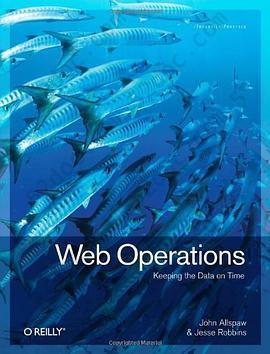注重体验与质量的电子书资源下载网站
分类于: 职场办公 编程语言
简介

Web Operations: Keeping the Data On Time 豆 9.1分
资源最后更新于 2020-08-19 16:04:09
作者:John Allspaw
出版社:O'Reilly Media
出版日期:2010-01
ISBN:9781449377441
文件格式: pdf
标签: 运维 web Operations 互联网 O'Reilly sysadmin 计算机 架构
简介· · · · · ·
A web application involves many specialists, but it takes people in web ops to ensure that everything works together throughout an application's lifetime. It's the expertise you need when your start-up gets an unexpected spike in web traffic, or when a new feature causes your mature application to fail. In this collection of essays and interviews, web veterans such as Theo Schl...
目录
Chapter 1 Web Operations: The Career
Why Does Web Operations Have It Tough?
From Apprentice to Master
Conclusion
Chapter 2 How Picnik Uses Cloud Computing: Lessons Learned
Where the Cloud Fits (and Why!)
Where the Cloud Doesn't Fit (for Picnik)
Conclusion
Chapter 3 Infrastructure and Application Metrics
Time Resolution and Retention Concerns
Locality of Metrics Collection and Storage
Layers of Metrics
Providing Context for Anomaly Detection and Alerts
Log Lines Are Metrics, Too
Correlation with Change Management and Incident Timelines
Making Metrics Available to Your Alerting Mechanisms
Using Metrics to Guide Load-Feedback Mechanisms
A Metrics Collection System, Illustrated: Ganglia
Conclusion
Chapter 4 Continuous Deployment
Small Batches Mean Faster Feedback
Small Batches Mean Problems Are Instantly Localized
Small Batches Reduce Risk
Small Batches Reduce Overhead
The Quality Defenders' Lament
Getting Started
Continuous Deployment Is for Mission-Critical Applications
Conclusion
Chapter 5 Infrastructure As Code
Service-Oriented Architecture
Conclusion
Chapter 6 Monitoring
Story: "The Start of a Journey"
Step 1: Understand What You Are Monitoring
Step 2: Understand Normal Behavior
Step 3: Be Prepared and Learn
Conclusion
Chapter 7 How Complex Systems Fail
How Complex Systems Fail
Further Reading
Chapter 8 Community Management and Web Operations
Chapter 9 Dealing with Unexpected Traffic Spikes
How It All Started
Alarms Abound
Putting Out the Fire
Surviving the Weekend
Preparing for the Future
CDN to the Rescue
Proxy Servers
Corralling the Stampede
Streamlining the Codebase
How Do We Know It Works?
The Real Test
Lessons Learned
Improvements Since Then
Chapter 10 Dev and Ops Collaboration and Cooperation
Deployment
Shared, Open Infrastructure
Trust
On-call Developers
Avoiding Blame
Conclusion
Chapter 11 How Your Visitors Feel: User-Facing Metrics
Why Collect User-Facing Metrics?
What Makes a Site Slow?
Measuring Delay
Building an SLA
Visitor Outcomes: Analytics
Other Metrics Marketing Cares About
How User Experience Affects Web Ops
The Future of Web Monitoring
Conclusion
Chapter 12 Relational Database Strategy and Tactics for the Web
Requirements for Web Databases
How Typical Web Databases Grow
The Yearning for a Cluster
Database Strategy
Database Tactics
Conclusion
Chapter 13 How to Make Failure Beautiful: The Art and Science of Postmortems
The Worst Postmortem
What Is a Postmortem?
When to Conduct a Postmortem
Who to Invite to a Postmortem
Running a Postmortem
Postmortem Follow-Up
Conclusion
Chapter 14 Storage
Data Asset Inventory
Data Protection
Capacity Planning
Storage Sizing
Operations
Conclusion
Chapter 15 Nonrelational Databases
NoSQL Database Overview
Some Systems in Detail
Conclusion
Chapter 16 Agile Infrastructure
Agile Infrastructure
So, What's the Problem?
Communities of Interest and Practice
Trading Zones and Apologies
Conclusion
Chapter 17 Things That Go Bump in the Night (and How to Sleep Through Them)
Definitions
How Many 9s?
Impact Duration Versus Incident Duration
Datacenter Footprint
Gradual Failures
Trust Nobody
Failover Testing
Monitoring and History of Patterns
Getting a Good Night's Sleep
Appendix Contributors
Colophon
Why Does Web Operations Have It Tough?
From Apprentice to Master
Conclusion
Chapter 2 How Picnik Uses Cloud Computing: Lessons Learned
Where the Cloud Fits (and Why!)
Where the Cloud Doesn't Fit (for Picnik)
Conclusion
Chapter 3 Infrastructure and Application Metrics
Time Resolution and Retention Concerns
Locality of Metrics Collection and Storage
Layers of Metrics
Providing Context for Anomaly Detection and Alerts
Log Lines Are Metrics, Too
Correlation with Change Management and Incident Timelines
Making Metrics Available to Your Alerting Mechanisms
Using Metrics to Guide Load-Feedback Mechanisms
A Metrics Collection System, Illustrated: Ganglia
Conclusion
Chapter 4 Continuous Deployment
Small Batches Mean Faster Feedback
Small Batches Mean Problems Are Instantly Localized
Small Batches Reduce Risk
Small Batches Reduce Overhead
The Quality Defenders' Lament
Getting Started
Continuous Deployment Is for Mission-Critical Applications
Conclusion
Chapter 5 Infrastructure As Code
Service-Oriented Architecture
Conclusion
Chapter 6 Monitoring
Story: "The Start of a Journey"
Step 1: Understand What You Are Monitoring
Step 2: Understand Normal Behavior
Step 3: Be Prepared and Learn
Conclusion
Chapter 7 How Complex Systems Fail
How Complex Systems Fail
Further Reading
Chapter 8 Community Management and Web Operations
Chapter 9 Dealing with Unexpected Traffic Spikes
How It All Started
Alarms Abound
Putting Out the Fire
Surviving the Weekend
Preparing for the Future
CDN to the Rescue
Proxy Servers
Corralling the Stampede
Streamlining the Codebase
How Do We Know It Works?
The Real Test
Lessons Learned
Improvements Since Then
Chapter 10 Dev and Ops Collaboration and Cooperation
Deployment
Shared, Open Infrastructure
Trust
On-call Developers
Avoiding Blame
Conclusion
Chapter 11 How Your Visitors Feel: User-Facing Metrics
Why Collect User-Facing Metrics?
What Makes a Site Slow?
Measuring Delay
Building an SLA
Visitor Outcomes: Analytics
Other Metrics Marketing Cares About
How User Experience Affects Web Ops
The Future of Web Monitoring
Conclusion
Chapter 12 Relational Database Strategy and Tactics for the Web
Requirements for Web Databases
How Typical Web Databases Grow
The Yearning for a Cluster
Database Strategy
Database Tactics
Conclusion
Chapter 13 How to Make Failure Beautiful: The Art and Science of Postmortems
The Worst Postmortem
What Is a Postmortem?
When to Conduct a Postmortem
Who to Invite to a Postmortem
Running a Postmortem
Postmortem Follow-Up
Conclusion
Chapter 14 Storage
Data Asset Inventory
Data Protection
Capacity Planning
Storage Sizing
Operations
Conclusion
Chapter 15 Nonrelational Databases
NoSQL Database Overview
Some Systems in Detail
Conclusion
Chapter 16 Agile Infrastructure
Agile Infrastructure
So, What's the Problem?
Communities of Interest and Practice
Trading Zones and Apologies
Conclusion
Chapter 17 Things That Go Bump in the Night (and How to Sleep Through Them)
Definitions
How Many 9s?
Impact Duration Versus Incident Duration
Datacenter Footprint
Gradual Failures
Trust Nobody
Failover Testing
Monitoring and History of Patterns
Getting a Good Night's Sleep
Appendix Contributors
Colophon








